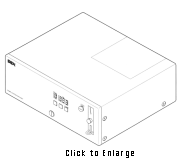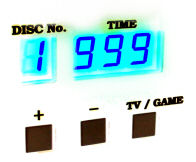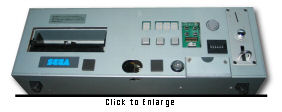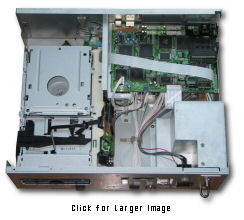|
Rare? You ain't seen nothin' yet.
A lot of things are considered rare, but it's a relative term. Before the internet made it easy to research and import things it was common to find what's rare in one country is common in another. The internet is a great equalizer, making information freely available to everyone and, very often, making the rare things appear less rare.
Sometimes a rare game like the PC Engine's Circus Lido, which often sold for over $600, is suddenly found in abundance, brand new, on Amazon Japan's website for fifty bucks. Sometimes a rare console like the Taiwanese Super A'Can, completely unheard-of in most of the world, is dumped en masse via surplus parts dealers in America. Once in a while the internet will confirm an  item's rarity, as with the HiSaturn Navi.
And then there's this thing.
If you search Google for the model number HSG-0007 you get absolutely nothing. The initials SGX are fairly common, but nothing related to this unit pops up. Could it then be that, yes, this system is rare?
Most serious collectors and players have never even heard of this system. Rumor suggested (and it was confirmed, see misinformation below) the popular import shop NCSX.com had one in stock in 1999. Certainly someone somewhere knows the production numbers, but if you consider the internet to be any kind of gauge then this SGX system is, without question, astonishingly rare.
What it is
 Produced by a company called SunSeibu for use in Japanese hotels this is, in essence, a coin-operated Saturn system. With a seven-disc CD changer inside the box. Using a remote control or the panel-mounted buttons the CDs can be easily cycled to select the game of choice. The coin slot activates the unit and a timer counts down the remaining play time. When the last minute comes up the system's internal speaker beeps. For the last ten seconds it beeps rather insistantly, giving the player ample time to slap in another hundred yen.
There are quite a few of these pay-to-play units released for hotel use in Japan. Both the Famicom and Super Famicom had one, as did SNK's Neo Geo system. SNES and Nintendo64 units were available in North American hotels also.
How it works
 The owner can configure it to run for a determined time whenever the proper number of coins are inserted. It can also be set to free-play, perfect for the home user. Two standard controllers can be connected to the rear of the unit, and it uses the standard AV cable and power cord. There's a slot for the VCD card, which I imagine was handy for love hotels that wanted less gaming and more entertainment. I'll say no more. There's a video passthrough so a VCR or TV tuner can be connected to the same TV. Both the remote and deck have a Game/TV switch to select the output.
What's outside
 There are only five controls accessible when the cover is on: power, coin, CD+ & CD-, and TV/Game. When the cover is removed (using a key) there are four additional buttons: CD Eject, Cartridge Eject, Credit and Reset. There's also a switch to enable the video passthrough (or not) when there's no credits on the clock. There are two LED displays, one shows the currently selected CD and the other shows remaining time in minutes.
Ports on the rear are your standard fare; two standard Saturn controller ports, a serial port (for a modem, since linking two of these is probable completely unheard of), AV in and AV out. There are three removable panels, one hides the VCD card and battery, one allows installation or removal of the remote unit (which is not cordless), and one on top allows access to the cartridge slot. This cartridge slot must use a special 90-degree riser, normal carts will not fit.
What's inside
Inside the system is exactly what you'd expect. A production Saturn PCB is used, with the battery, VCD and serial ports accessible from the rear. Interestingly a standard Saturn power supply is also used, though the AC plug has been removed and there's now a cable providing power to the PCB where normally the supply is connected directly. A large JVC CD changing mechanism, the same as found in their home audio equipment with a 6-CD cartridge and a single tray, provides the disc-swapping capability.

The only parts of the Saturn PCB that are used normally are the serial port, VCD slot and battery. The rest are moved to other locations in the box. The controller ports and AV output are re-routed to a small PCB mounted under the Saturn PCB. The controller ports are connected with a ribbon cable, the video output  from the Saturn is connected via three wires soldered to the base of the Saturn board. These wires are the only changes made to the Saturn PCB.
The BIOS is standard Sega Saturn fare, nothing special to see here, no special bootup images or anything.
The system is set to Japanese, though you can set the language like any normal Saturn via the boot menu. Since it uses a standard Saturn board you can easily configure it to run games from any region. It's trivially easy to connect the RGB or Svideo output as well, however this will obviously bypass the video passthrough function.
What's included
When new the system comes with pretty much everything. One JVC standard 6-CD cartridge, VCD card, two controllers, remote control, AC + AV cables, and manual. There's also a security-TORX tool to remove the screws holding the back panels (and the rest of the system) together. In addition there are two sets of keys, one for the front panel and one for the coin box inside.
Misinformation
NCSX.com apparently took delivery of an SGX system on 25th January, 1999 ( Wayback Archive). In this and a followup article ( Wayback Archive) they talked about some interesting facts and some silly guesses. What is probably fact is the price, USD $1150. What is ludicrous conjecture is the idea that it's for arcade coin-op use; the system doesn't output RGB. The idea that it could be used in a retail setting as part of a pay-to-play demo kiosk is similarly absurd, no Japanese store now or then charges for trialling software, and there's no space for a behemoth like this in your average game store. These seem to be conclusions one might draw if one was unaware of the hotel-boxes commonly available in Japan.
The VCD card was not, as they suggest, built in to the unit any more than a normal Saturn's VCD card is built in. It comes with the system but is not even semi-permanently installed, it comes packaged in the standard retail box and is optional.
There is no way the system knows if a game is being played or if a VCD is being viewed, so the idea that these can be timed or paid-for differently is erroneous. The dipswitches available allow only the credits-per-coin and time-per-credit settings to be adjusted. There's one more switch to enable the video passthrough when no time remains on the counter,  and there's a 'demo' mode where [something interesting happens, this part of the manual is written in some sort of gibberish moon-language (called Japanese in some circles) and I'm not sure the exact meaning].
Thanks to Manu for digging up this info.
|  item's rarity, as with the HiSaturn Navi.
item's rarity, as with the HiSaturn Navi.

 Produced by a company called SunSeibu for use in Japanese hotels this is, in essence, a coin-operated Saturn system. With a seven-disc CD changer inside the box. Using a remote control or the panel-mounted buttons the CDs can be easily cycled to select the game of choice. The coin slot activates the unit and a timer counts down the remaining play time. When the last minute comes up the system's internal speaker beeps. For the last ten seconds it beeps rather insistantly, giving the player ample time to slap in another hundred yen.
Produced by a company called SunSeibu for use in Japanese hotels this is, in essence, a coin-operated Saturn system. With a seven-disc CD changer inside the box. Using a remote control or the panel-mounted buttons the CDs can be easily cycled to select the game of choice. The coin slot activates the unit and a timer counts down the remaining play time. When the last minute comes up the system's internal speaker beeps. For the last ten seconds it beeps rather insistantly, giving the player ample time to slap in another hundred yen.

 There are only five controls accessible when the cover is on: power, coin, CD+ & CD-, and TV/Game. When the cover is removed (using a key) there are four additional buttons: CD Eject, Cartridge Eject, Credit and Reset. There's also a switch to enable the video passthrough (or not) when there's no credits on the clock. There are two LED displays, one shows the currently selected CD and the other shows remaining time in minutes.
There are only five controls accessible when the cover is on: power, coin, CD+ & CD-, and TV/Game. When the cover is removed (using a key) there are four additional buttons: CD Eject, Cartridge Eject, Credit and Reset. There's also a switch to enable the video passthrough (or not) when there's no credits on the clock. There are two LED displays, one shows the currently selected CD and the other shows remaining time in minutes.


 and there's a 'demo' mode where [something interesting happens, this part of the manual is written in some sort of gibberish moon-language (called Japanese in some circles) and I'm not sure the exact meaning].
and there's a 'demo' mode where [something interesting happens, this part of the manual is written in some sort of gibberish moon-language (called Japanese in some circles) and I'm not sure the exact meaning].